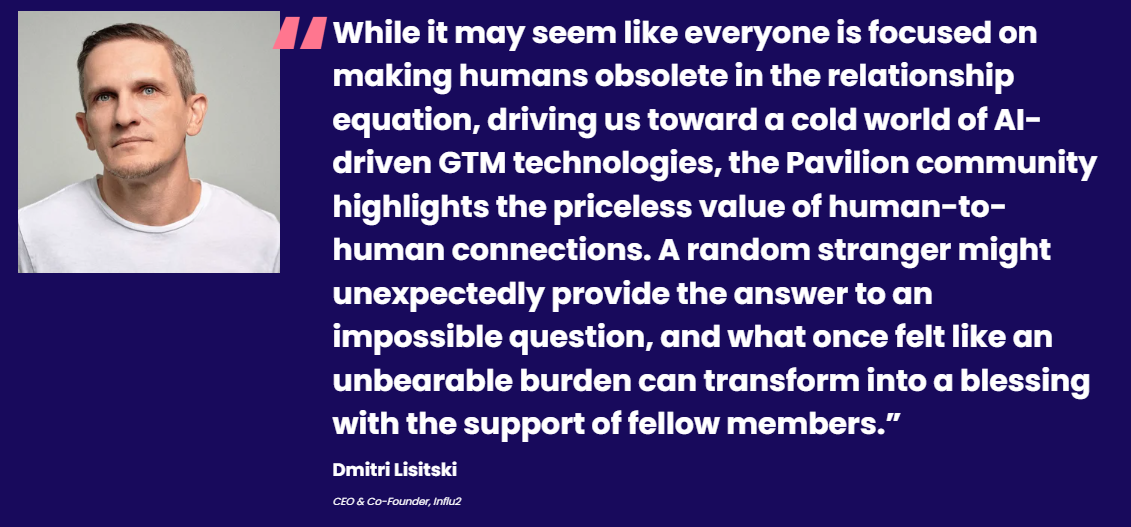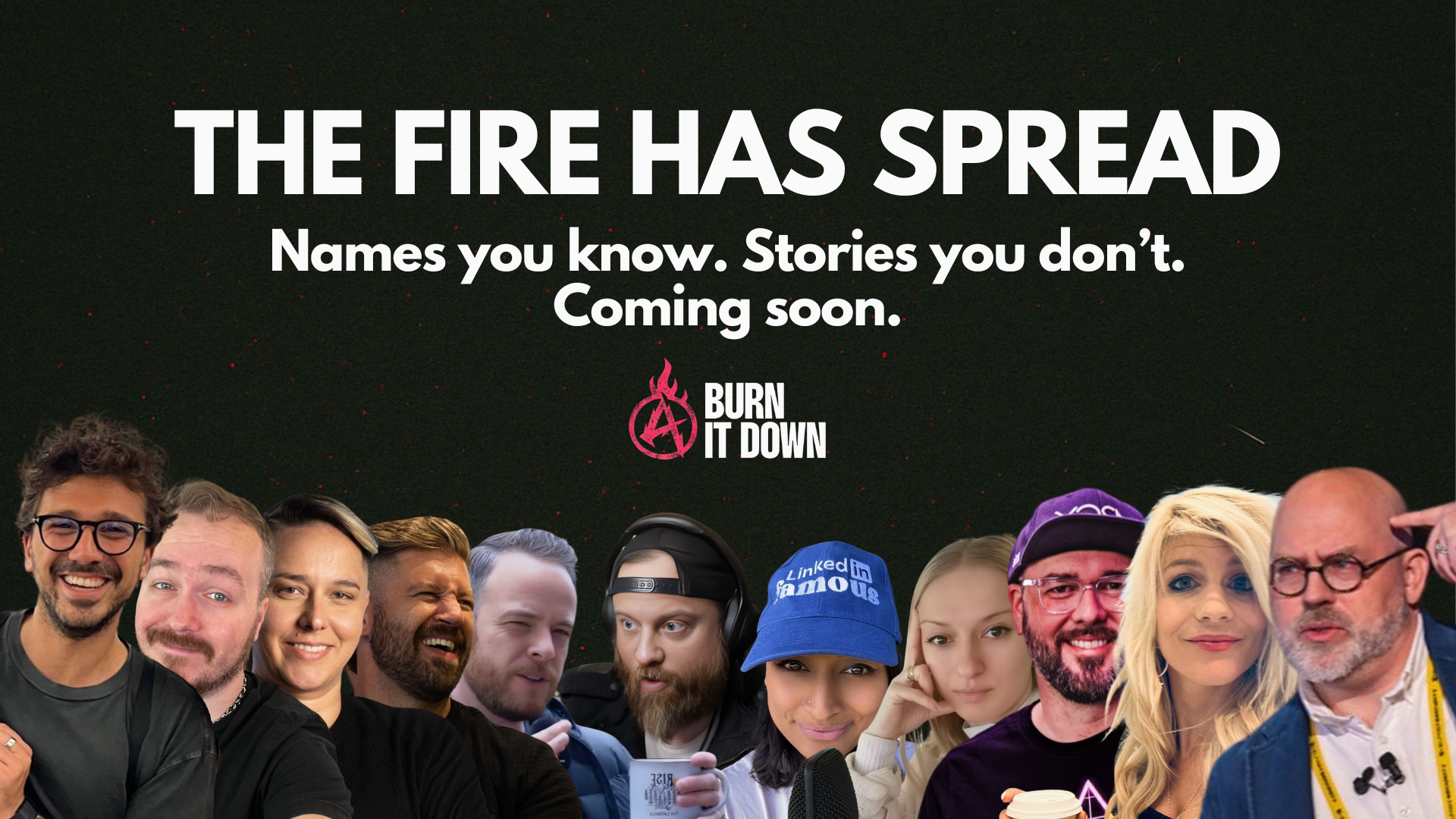Yesterday, Pavilion CEO, Sam Jacobs posted what looked like independent research on LinkedIn.
Clean charts, authoritative insights, the Pavilion brand stamped all over it.
"Revenue generation is a team sport," he wrote, promoting a report on "The Evolution of GTM Strategy" that endorsed contact-level targeting and sophisticated attribution measurement.
It looked like education.
It was actually advertising.
The report was co-branded with Influ2, a martech vendor that sells "contact-level advertising" technology.
But this wasn't disclosed as sponsored content or vendor collaboration
Sam presented it as research "we put together" - independent insights from the trusted Pavilion brand.
What (definitely not) nobody realized: they were reading a sales pitch disguised as education, while being surveilled by the same vendor's tracking technology.
Let me show you exactly how Pavilion became a credibility laundromat for martech influence, why the technology they're promoting is sophisticated visitor surveillance, and how Sam Jacobs betrayed his own community by selling educational authority to companies that spy on marketing leaders.
How Influence Laundering Works
Here's what Sam's LinkedIn post claimed:
"That's from a report we put together with Influ2 on the evolution of GTM. I've seen it time and time again. When Sales and Marketing aren't aligned – the entire machine slows and eventually grinds to a halt."
Notice the framing: "research we put together" - not "sponsored content from our paying partner" or "deliverable from Influ2's sponsorship package."
The post included professional charts, quoted industry leaders, and presented four "key opportunities" for GTM efficiency. It looked like the kind of independent research that made Pavilion's reputation as an unbiased educator.
But then I found Pavilion's sponsorship page.
Pavilion's Influence Marketplace
Pavilion openly sells sponsorship packages that include "co-branded ebooks" where brands can "collaborate on a thought leadership piece, designed and distributed by Pavilion."
And guess who appears as a satisfied customer testimonial on that same sponsorship page?
Dmitri Lisitski, CEO & Co-Founder of Influ2.

His quote talks about the "priceless value of human-to-human connections" and positions him not as a vendor, but as a trusted community member whose wisdom should be respected.
The perfect circle of corruption:
- Influ2 pays Pavilion for sponsorship package
- Gets co-branded "research" report as deliverable
- Dmitri provides glowing testimonial about Pavilion's value
- Report gets distributed as unbiased education
- Pavilion uses Dmitri's testimonial to sell more sponsorships
This isn't accidental collaboration. It's systematic influence laundering.
The Content Problem: Attribution Theater Disguised As Research
The report itself reads like a 12-page sales deck for Influ2's technology.
And if you were alive in 2017, you've already heard every single "insight" in it.
Every single recommendation perfectly aligns with their product capabilities:
"Opportunity 1: Create audience alignment between Sales and Marketing"
Standard advice that any consultant could give, designed to soften you up for the real pitch.
"Opportunity 2: Use contact-level targeting to connect with key decision makers"
Translation: Buy Influ2's "person-based marketing" technology instead of traditional account-based marketing.
"Opportunity 3: Operationalize data to reveal intent signals"
Translation: Use Influ2's visitor identification technology to track individual behavior.
"Opportunity 4: Measure Marketing's influence on pipeline and revenue"
Translation: Buy Influ2's attribution modeling to claim credit for revenue you didn't actually influence.
The methodology?
"We spoke with five GTM leaders."
That's customer interviews packaged as industry analysis.
The Technical Impossibility
The report claims marketers can track "who saw and clicked each ad, even if that viewer doesn't fill out a lead gen form" and measure "marketing-influenced revenue that goes beyond typical attribution models."
This is technically impossible at the scale they're claiming.
You can't deterministically track individual decision-makers through complex B2B buying processes across multiple companies, devices, and time periods.
What they're actually selling is correlation disguised as causation - the same attribution theater that's been destroying marketing credibility for years.
The Hosting Reveals The Truth
Here's where it gets worse.
The report isn't just co-branded with Influ2 - it's hosted on Influ2's website under their "playbooks" section at influ2.com/playbooks/evolution-of-gtm-strategy.
On Influ2's site, it appears to be their educational content that they "collaborated" with Pavilion on. But Sam presents it as Pavilion research that Influ2 helped with.
Both sides are claiming ownership while pretending it's independent research.
It's Influ2 buying Pavilion's credibility to launder their sales messaging into "thought leadership."
The Technical Horror: What Influ2's Technology Actually Does
But here's the most disturbing part.
I examined the technical implementation of Influ2's "contact-level advertising" technology by looking at the tracking code on the very page hosting their Pavilion report.
What I found was comprehensive visitor surveillance disguised as marketing measurement.
The Tracking Script Breakdown
Every visitor to that report page gets tracked by this script:
<script src="//www.influ2.com/tracker?clid=00df510f-dc51-4743-bf92-0623b8b662c0"></script>Here's what that script actually does:
1. Visitor Identification (Deanonymization)
- Reverse IP lookup to identify your company
- Cross-database matching against B2B data providers
- Persistent tracking with unique IDs that follow you across sessions
- Cookie harvesting from other marketing platforms (specifically HubSpot)
2. Behavioral Surveillance
- Tracks every mouse movement, scroll, and touch interaction
- Measures engagement time down to milliseconds
- Records click patterns and page interaction depth
- Monitors when you switch tabs or leave the page
3. Form Pre-filling (The Creepy Part)
// Auto-fills form fields with data they have about you
i[t].value=e[n];The script automatically populates form fields with personal data they've collected about you - name, company, email - without your knowledge or consent.
4. Dynamic Retargeting Injection
// Injects personalized tracking pixels based on your profile
t.innerHTML=e;
document.body.appendChild(t);They fetch personalized tracking pixels from their servers and inject them into the page based on who you are.
5. Cross-Platform Attribution Theater
- Integrates with Google Analytics, Mixpanel, and HubSpot
- Builds attribution models claiming credit for conversions
- Creates "marketing-influence" reports based on correlation
It's visitor surveillance disguised as attribution measurement.
The HubSpot Cookie Harvesting
The most invasive part is how they steal tracking data from other marketing platforms:
// Extracts HubSpot tracking cookies
l=document.cookie.split("; ").find(e=>e.startsWith("hubspotutk="))What most HubSpot users don't realize: Other companies can read your HubSpot tracking cookies and potentially identify your visitors.
Marketing teams think: "My HubSpot visitor data is private to my company."
Reality: "Any website my HubSpot visitors browse can read their tracking cookies and cross-reference them with data enrichment services."
Influ2 is systematically harvesting HubSpot visitor data to build cross-platform surveillance profiles. They're not just tracking their own visitors - they're spying on other companies' marketing data.
And if you're saying,
"Well, yeah... but every vendor does that..."
Yeah, no shit.
That's a problem.
You know what's a bigger problem?
Community Betrayal At Scale
Here's the complete picture of what Pavilion and Influ2 orchestrated:
- Pavilion builds credibility as the trusted education platform for marketing leaders
- Influ2 pays for that credibility through sponsorship collaboration
- Pavilion endorses surveillance technology as "contact-level targeting" best practices
- Marketing leaders implement the surveillance thinking it's cutting-edge strategy
- Influ2's tracking code surveils those same marketing leaders when they visit websites
- The Pavilion community gets spied on by technology their trusted educator promoted
The ultimate irony: The people reading Pavilion's "research" about contact-level advertising are being contact-level advertised TO by the vendor who paid for the research.
Read that again.
Education vs. Influence Laundering
Let's make something very clear here:
There's a huge difference between legitimate sponsored content and what Pavilion did here.
Legitimate Sponsored Content:
- "This post is sponsored by X"
- "Paid partnership with Y"
- Clear disclosure of financial relationship
- Audience knows it's vendor messaging
What Pavilion/Influ2 Did:
- Present vendor sales messaging as independent research
- Co-brand it as collaborative "thought leadership"
- Distribute through trusted educational channels
- Zero disclosure that it's a paid deliverable
The problem is in the framing.
When Pavilion's brand appears on vendor messaging, it transfers educational credibility to sales content.
Thousands of marketers see "Pavilion research" and trust it as unbiased analysis.
As much as I'm sure as much as Pavilion, Influ2, and myriad other vendor bootlickers will tell you, "I mean... everybody knows it's a brand deal."
No. They. Fucking. Don't.
The vast majority of that audience has no idea they're reading purchased vendor messaging disguised as independent education.
And that kind of accountability dodging and systemic, industry-wide gaslighting is exactly the kind of bullshit that got B2B marketing into this mess in the first place.
How Education Gets Corrupted
This isn't just about one bad report.
It's about how vendor money corrupts the entire "education" ecosystem in marketing.
The Authority Transfer Problem
When trusted education brands like Pavilion co-brand with vendors, they transfer their credibility to sales messaging. Bad ideas get wrapped in trusted brands, then distributed as "research" to communities that don't realize they're reading marketing disguised as education.
The Influence Marketplace
Pavilion's sponsorship page proves this is systematic. They're literally selling access to influence thousands of marketing decisions. Other vendors will want the same treatment, creating a marketplace where educational authority goes to the highest bidder.
The End of Unbiased Education
If education platforms become vendor marketing channels, where do marketing leaders get actual unbiased insights? When the most trusted names become influence brokers, the entire ecosystem gets poisoned.
Who Actually Pays
When marketing leadership buys into attribution fantasies and surveillance technology, the cost rolls downhill:
Demand gen managers get blamed for not "optimizing contact-level conversion rates" on technology that doesn't work as advertised.
Marketing ops teams get pressured to build dashboards around directional signals disguised as actionable metrics.
CMOs get fired for missing targets based on attribution models that were never connected to actual marketing influence.
Meanwhile, the vendors who sold the fantasy and the education platforms that laundered their credibility move on to the next metaphor, the next dashboard, the next "revolutionary measurement breakthrough."
From Educator to Influence Broker
Sam Jacobs built his reputation as the unbiased voice teaching marketers how to navigate vendor bullshit and focus on what actually drives results.
Then he started selling that credibility to the highest bidder.
The Transformation
- Phase 1: Build trust as independent educator and community leader
- Phase 2: Monetize that trust through vendor sponsorship programs
- Phase 3: Launder vendor messaging as educational content
- Phase 4: Community treats purchased influence as trusted insights
The Authority Corruption
When Sam posts vendor messaging as Pavilion research, his audience doesn't see a sales pitch - they see wisdom from a trusted educator.
That authority transfer is what makes influence laundering so effective and so destructive.
The Community Betrayal
Sam didn't just sell his credibility. He sold it to promote technology that surveils his own community members.
The marketing leaders who trust his educational content become victims of the surveillance technology he endorsed.
The Influ2 Model
Understanding what Influ2 actually sells helps explain why they needed Pavilion's credibility washing.
What They Claim To Sell
"Contact-level advertising" and "marketing influence measurement" - sophisticated attribution technology that helps marketers understand buyer behavior.
What They Actually Sell
Comprehensive visitor surveillance that harvests data from multiple marketing platforms, builds persistent tracking profiles, and creates attribution theater based on correlation.
Why They Needed Pavilion
Surveillance technology is hard to sell directly.
But "contact-level targeting" endorsed by trusted educators?
That sells itself.
Pavilion provided the credibility washing that made privacy invasion look like marketing sophistication.
What Marketers Should Actually Do
Subscribe to Burn It Down now for as little as $10/mo. or $100/yr.
See what I did there?
Yeah, you won't learn that from Pavilion.
Just think of how many paid subscriptions you could gift to people for the price of that "Executive Membership".
Sheesh.
Feeling the burn yet?
The marketers that already have are in The Inner Circle.
Instead of implementing surveillance technology disguised as attribution measurement, marketing leaders should focus on what they can actually control:
Create Content Worth Discovering
Focus on building genuine expertise and valuable insights rather than trying to track how people discover them.
Build Brand Clarity
Make your value proposition immediately obvious regardless of how people find you, since you can't control discovery mechanisms anyway.
Optimize Post-Discovery Experience
Since attribution is mostly theater, focus on converting visitors after they arrive rather than trying to manipulate how they discover you.
Accept Attribution Limitations
Most buyer behavior isn't controllable by marketing campaigns. Accepting that limitation lets you focus on creating actual value instead of chasing measurement ghosts.
Question Educational Authority
When education platforms start co-branding with vendors, treat their insights with appropriate skepticism.
Always ask: who benefits from this advice?
Saving Marketing From Surveillance
The Pavilion-Influ2 collaboration represents something bigger than one corrupted report.
It's emblematic of how surveillance capitalism has infected B2B marketing education.
The Normalization Process
- Vendors develop invasive tracking technology
- Education platforms launder it as "best practices"
- Marketing leaders implement surveillance thinking it's sophisticated strategy
- Privacy invasion becomes normalized as "advanced marketing"
The Ecosystem Corruption
When the most trusted education brands become vendor marketing channels, the entire industry loses access to unbiased insights. Everything becomes influenced by whoever pays the most for credibility washing.
The Solution
Marketing leaders need to recognize when they're being sold surveillance disguised as sophistication.
The technology that promises perfect attribution and contact-level measurement is the same technology that turns website visitors into products for martech vendors.
The Choice: Education or Influence Marketplace
The marketing community faces a choice about what kind of education ecosystem it wants:
Option A: Trusted platforms that provide unbiased insights, even when those insights are uncomfortable or don't benefit vendor profits.
Option B: Influence marketplaces where educational authority goes to the highest bidder and vendor messaging gets disguised as community wisdom.
Pavilion chose Option B. They transformed from educators to influence brokers, selling their credibility to vendors and laundering sales messaging as research.
The cost of that choice isn't just Pavilion's reputation. It's the corruption of marketing education itself.
Time to Demand Better
If you're part of the Pavilion community, you trusted Sam Jacobs to provide unbiased education about marketing strategy.
Instead, you got vendor sales messaging disguised as research, endorsed by the platform you thought was protecting you from exactly this kind of manipulation.
So, I'm going to say this to every single Pavilion member out there with a straight face:
You know it's bullshit.
I know that you know it's bullshit.
You know you deserve better than credibility laundering.
You deserve education that isn't purchased by the vendors it evaluates.
You deserve insights that prioritize your success over vendor profits.
You deserve transparency about when educational content is actually paid vendor messaging.
And hey, if you just simply want to be in the pink shirt clique for the networking and free vendor swag...
Hell, maybe you conned your org into paying for it.
I get it.
I mean that.
But don't tell me you learned something...
because you know you didn't.
You deserve educators who don't sell your trust to vendors.
The Bottom Line:
Keep The Change
It's right there on the Pavilion homepage:
"A trusted space for GTM professionals to learn, share, and grow. Access actionable insights, world-class education, and meaningful connections that help you succeed at every stage of your career."
Bullshit, Sam.
Bullshit.
The marketing community has trusted Pavilion to be different for years.
Instead, they became exactly what they claimed to protect against: vendor influence disguised as education.
When education platforms become credibility laundromats, everyone loses - except the vendors who can afford to buy influence.
Keep the change, Sam.
The community deserves educators who aren't for sale.
The Influ2-Pavilion report is still live at influ2.com/playbooks/evolution-of-gtm-strategy, complete with comprehensive visitor surveillance.
Every person who reads their "research" about contact-level advertising gets contact-level advertised to by the same technology.
The irony would be perfect if it weren't so predatory.
If this made attribution vendors, Pavilion members, Sam Jacobs, and other influence broker wannabees uncomfortable, good.
It was supposed to.
This isn’t a guest series. It’s a coordinated breach.
Nine minds. Nine voices. One mission: Burn it all down.
About the Author:
Clark Barron is the founder of Burn It Down—a rogue media platform built for marketers who know something’s wrong but don’t know who to trust anymore.
He’s spent 15 years inside the machine, consulted with some of the biggest names in tech, SaaS, and cybersecurity, and now publishes the exposés no one else will touch—armed with proof, rage, and receipts.
His work is read by tens of thousands of marketers, sellers, operators, and founders who are done pretending this shit is normal.


